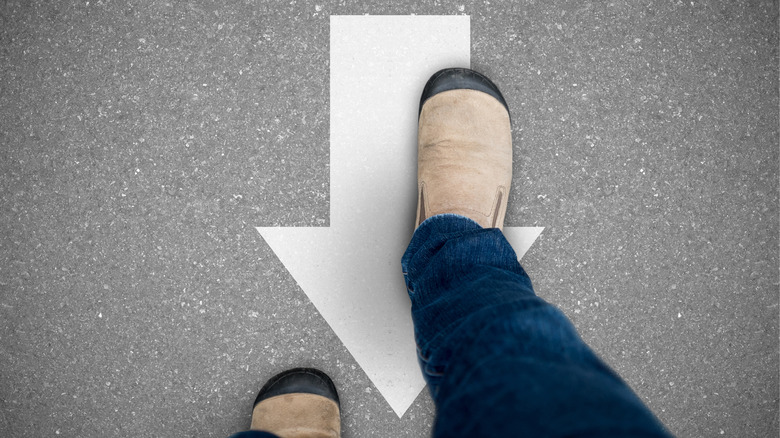Why People Over 50 Should Try Walking Backward For Healthy Aging
Life after 50 can be as healthy as you make it. Not only is it a time when you're more sure of yourself than ever, but it's also the age when you've (hopefully) found peace and enjoyment in your daily routine, whether that involves work, exercise, spending time with family, or pursuing hobbies. On the exercise front, TIkTok is exposing us (once again) to the many merits of walking backward. Apparently, if you're not clued in to this simple exercise, you're doing something wrong.
Turns out, this particular physical activity can help improve balance, relieve lower back pain, help manage osteoarthritis, improve some cognitive abilities, and more. One of the earliest mentions of walking backward, also referred to as retro-walking or retro-ambulation, is credited to Patrick Harmon, who in 1915 (aged 50), walked backward from San Francisco to New York, allegedly on a $20,000 bet. Apparently his ankles were so sturdy afterward that he is reported to have said that "it would take a sledge hammer blow to sprain them," according to the BBC.
Various experts have since become interested in retro-ambulation. According to clinical exercise specialist André Noël Potvin (via CBC), walking backwards is beneficial for people with back, hip, knee, and ankle problems. "One of the key things that happens when walking backward is the ankle absorbs shock differently and therefore it gets stronger," he explained. Harmon had stumbled on something helpful, evidently. So how exactly does walking backwards improve your health?
How does retro-walking physically benefit people over 50?
The risk of falls and injury increases as you age. Issues related to balance and walking are common concerns when it comes to your body after age 50. They are also one of the main causes of falls. Experts claim walking backward can greatly help in this area. By employing different muscles than you would when walking forward — namely, your glutes, hamstrings, and even shins – you're improving your balance over time. A 2016 study published in the Journal of Physical Therapy Science showed significant benefits to walking backwards.
Additionally, strengthening (and flexing) your glutes and hip flexors through retro-walking can help with lower back pain, said physical therapist, Kristyn Holc (via Scientific American). "The muscles within your hips and in your bottom become really important for promoting functional mobility and reducing pain," explained Holc. And speaking of mobility, maintaining (and even improving) your range of motion to be able to do everyday tasks like placing an object in an elevated pantry cupboard become more important for those over 50. Retro-ambulation can help with that too.
Unlike walking forward, retro-walking is less stressful on your joints. This is great if you're trying to avoid injury, manage joint pain, or deal with arthritis. "It can often provide an alternate source of exercise for someone with injury or degeneration (arthritis) because walking backward can often avoid using those injured or degenerated muscles or joint components (ligaments, arthritic areas and menisci) that walking forward aggravate," explained sports medicine physician, Dr. Rand McClain, per TODAY.
How your brain can benefit from walking backwards
Sometimes, as you grow older, you are met with the bleak realization that your brain is aging faster than you are. Retro-ambulation offers several brain-related benefits including improved focus, an enhanced sense of awareness, and more.
According to exercise physiologist Tom Holland (via Scientific American), walking backwards can sharpen your brain's ability to collect more data than what is readily available by sight, a skill that could prove increasingly useful for those over 50 who may also deal with deteriorating vision. This is called proprioception, per the expert — your ability to sense the movement, action, and location of your body.
Plus, engaging in this simple activity causes your brain to use regions related to decision making and problem solving. Just contemplating backwards motion can improve a person's memory recall, according to a 2019 study published in the journal Cognition. Neurodegenerative conditions, memory issues, and even problems with cognitive capabilities become more common with age. Retro-ambulation could potentially be helpful in this regard.
How to start walking backward (safely)
If you're already privy to the benefits of retro-walking and have been doing it since it first showed up on your radar, then good for you. You've found one important activity that can slow down aging.
For amateur retro-walkers, there are a few things to keep in mind. For starters, if you have any existing musculoskeletal conditions or other health concerns that could make this exercise potentially dangerous, you should speak with your doctor before attempting it. Starting off on a treadmill (with the help of a safety clip) could greatly aid you in getting used to this unusual form of walking. The handrails can offer additional support. Start at slower speeds and slowly up the pace as you get comfortable.
If you don't own a treadmill or don't have access to one, or if you want to take it outdoors, start with a walking path or area you know relatively well. If you take a friend with you, they can help be your eyes as you navigate walking backward. Another way to engage in retro-ambulation is to alternate between walking forward and retro-walking. For example, five minutes of walking forward and one minute of walking backward. This way, you have a general idea of your surrounding landscape when you switch on the backward gear. After four weeks of 10-minute-long backward walking, three times a week, you will start to see the benefits, per Kristyn Holc (via Scientific American). Oh and, be prepared for quizzical looks from passersby. That's part of the fun.


